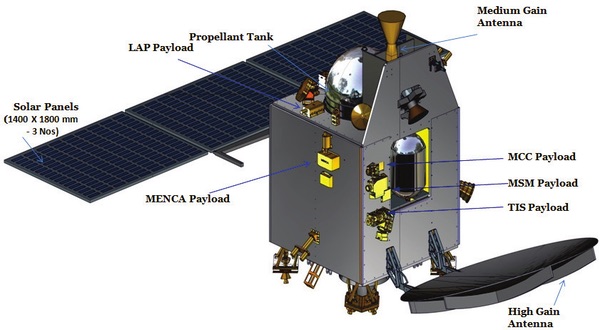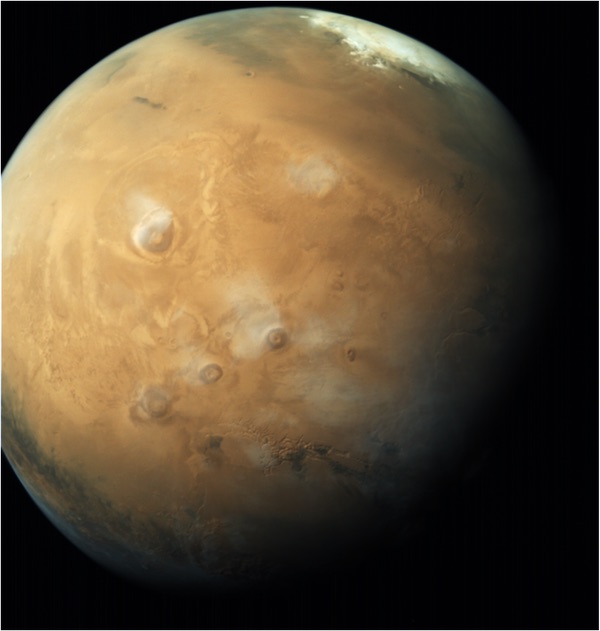
India’s Mars orbiter completes six years at the red planet, but where is the science?by Jatan Mehta
|
| According to ISRO’s official list of publications, there have been only 27 peer-reviewed papers relating to Mangalyaan after six years in orbit |
India’s pride in the mission while downplaying others has continued to spread over the years, also taking the form of dramatized movies like Mission Mangal. But what they all miss is looking at the science output i.e. what has Mangalyaan been doing in Mars orbit?
According to ISRO’s official list of publications, there have been only 27 peer-reviewed papers relating to Mangalyaan after six years in orbit. In contrast, MAVEN has helped produce many seminal scientific results about the Martian atmosphere, with a repository of at least 500 papers and growing. What’s more concerning about Mangalyaan’s short publications list is that about half of those are simply engineering descriptions of the mission, not scientific results from the mission.
Naysayers may dismiss the lack of science by arguing that Mangalyaan was a technology demonstration mission, aimed at proving ISRO’s interplanetary mission capabilities. That may be part of it, but that’s not how ISRO marketed the mission before and after its launch, when it was vocal about the science goals.
ISRO has made data from Mangalyaan’s five indigenous science instruments available on their data portal for five years now, and has explicitly welcomed the Indian science community to publish papers. In 2017, ISRO announced at the mission’s dedicated science meet that 32 research teams across the country are exploring and analyzing Mangalyaan data. And yet, there is a huge vacuum of publications.
Perhaps the most notable failure concerns the much-hyped methane sensor. The instrument was supposed to globally map methane with a sensitivity of parts per billion, to help decide if the methane on Mars could be a sign of subsurface life. But two years after launch, the instrument was found to have a design flaw and can’t detect methane at all. At that point, ISRO repurposed the methane sensor as an albedo mapper, which measures sunlight reflected from the surface to get hints about Mars’ surface composition.
There also seem to be no published results from the Lyman Alpha Photometer. By looking for hydrogen escaping the Martian atmosphere, it was supposed to tell us how much water Mars lost since its formation and at what rate. Notably, NASA’s MAVEN spacecraft was also expected to deliver this result (by examining many more factors), and it delivered.
 The instruments and other major components of Mangalyaan. (credit: ISRO) |
If the cost argument is to be made to justify some or any part of the missing science, ISRO’s own Chandrayaan 1 refutes it. At $54 million, it was cost effective too, and an equally challenging endeavor given that it was India’s first lunar orbiter.
| Both the missing collaborations and lack of scientific output from Mangalyaan’s indigenous instruments may have to do with the mission’s development time, which was just 18 months. |
Unlike Mangalyaan though, Chandrayaan 1 welcomed global collaboration: about half the instruments came from foreign space agencies and universities. Notably, it was the two NASA instruments that confirmed the discovery of water on the Moon. Despite orbiting the Moon for less than a year, Chandrayaan 1 produced hundreds of publications and scientists are analyzing its data even today.
This is not to say that ISRO can’t build good science instruments but rather to point out that collaboration can be an effective way to increase mission science without increasing mission cost. For some reason, ISRO doesn’t even fly science instruments from universities and institutions within the country for its planetary missions. The only exception has been India’s first space telescope, Astrosat, whose instruments were selected as a consensus among academic institutions across the country. But that’s not planetary exploration per se, for which ISRO operates differently. ISRO does intend to change this method in the future as part of its space commercialization initiative by involving private players and academic institutions.
Both the missing collaborations and lack of scientific output from Mangalyaan’s indigenous instruments may have to do with the mission’s development time, which was just 18 months. It’s unclear why ISRO was in such a hurry to launch in 2013 and couldn’t have targeted the 2016 launch opportunity instead. The reason may be political: the urge to successfully orbit Mars before China or Japan does.
Had Mangalyaan been given enough time, the scientific instruments package likely wouldn’t have been restricted to the mere 15 kilograms, and the output could’ve been substantial even with indigenous instruments. For example, ISRO’s Chandrayaan 2 orbiter carries state-of-the-art instruments, all indigenous, and is making the highest-resolution map of the Moon and quantifying water on its poles as we speak.
Another way Mangalyaan’s value could’ve been improved was if ISRO equipped it with a standard relay device, one that every NASA Mars orbiter carries. These orbiter relays allow NASA to get more science data from its surface missions than would be possible otherwise. The European Space Agency put one such device for NASA on their Trace Gas Orbiter, launched in 2016. If ISRO had done that too, instead of talking to NASA’s Curiosity on Twitter, Mangalyaan could’ve talked to the real deal.
 A global view of Mars taken by Mangalyaan in October 2017 from an altitude of 70,157 kilometers. (credit: ISRO) |
More than the quality of the science instruments or mission planning, Mangalyaan highlights the lack of an overarching philosophy guiding India’s planetary missions. By contrast, NASA has an elaborate process called the decadal survey in which scientists from across the US present a consensus of prioritized space exploration destinations and scientific objectives once every decade. NASA uses the decadal as a guide to build its missions, and the system therefore guarantees that said scientific goals are achieved more often than not. China and the European Space Agency have similar processes in place for their missions.
| India could benefit immensely from a formal planetary exploration framework, which either doesn’t exist or whose functioning is inept and unclear to the public. |
Space exploration missions are inherently costly undertakings, and at this point, the value matters as much as the absolute cost, if not more. MAVEN highlights this adequately. The mission, part of NASA’s larger Mars exploration program, is built with the express purpose of studying Mars’ atmosphere and determining exactly how the Red Planet lost its water. Thanks to its clear objectives, MAVEN delivered big science while still costing NASA less than many of its other endeavors, even if costing more than Mangalyaan.
Like NASA’s other missions, MAVEN’s findings feed directly into the agency’s next steps in Mars exploration and planning of future missions, further cementing the value proposition of such a model. India could benefit immensely from a formal planetary exploration framework, which either doesn’t exist or whose functioning is inept and unclear to the public.
ISRO plans to launch Mangalyaan 2 in 2024 with an upgraded orbiter, with a capacity of 100 kilograms for scientific instruments. The mission could also include a lander and a rover, but it seems unlikely at the moment. Notably, Mangalyaan 2 will launch after the first Mars rover missions from China and the European Space Agency, and alongside NASA’s ever-present Mars fleet. Let us hope Mangalyaan 2 is an appropriate step forward in this journey.
Note: we are temporarily moderating all comments submitted to deal with a surge in spam.